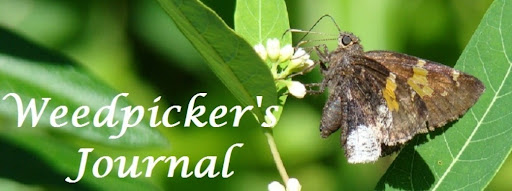Our ecosystems are not frozen in time. Every passing year and each natural or unnatural impact changes the way the land and its tapestry of plants respond. Left unmanaged, plants grow and change by natural succession. Natural or unnatural impacts may include flood, drought or fire. All are powerful forces upon our fields and forests.
.JPG) |
| Daughmer Prairie, just about to burn. |
Sometimes these forces are unexpected and unwanted. Other times, they are a tool for land management. It is an accepted practise to use fire to maintain open places- like prairies. This is nothing new, the First Nations of North American used fire as a tool long before white men arrived on the scene.
 |
| Cheryl Boyd Harner and John Boyd |
Only now have I realized, I have grown up to be
just like my father. Dad has always been a bigger-than-life influence upon me, and he was a Plant Manager. Now grant you, he is an electrician and mechanical wizard, who happened be be the Plant Engineer at a Goodrich factory.
As a Weedpicker, I am a bit of a plant manager too, albeit a more "hand's on" type. I have often been involved in managing habitats for invasive species. From chopping and popping
Teasel at Daughmer Prairie to
Garlic Mustard control at Magee Marsh, habitats often need a little help from their friends.
 |
| Winter creeper, Euonymus fortunei |
Many of the plants that become problematic in natural areas were intentionally introduced, for example, Winter Creeper. Planting Winter Creeper must have seemed like a
good idea to the past owner of my property and it was probably recommended by a landscaper as "easy to grow." Unfortunately, just as easily, it gets out-of-control.
 |
| Winter Creeper up a tree... |
Out it wanders, into native areas, climbing trees and coating the land in a thick matted blanket of green. It seems attractive enough until you notice it has eaten all of your plants, even Hosta does not stand a chance against this thug.
 |
| Weedpicker to the rescue. |
Fall is a great time to manage invasive plants. I am dragging the Winter Creeper out manually, as I do not want to kill the plants remaining beneath it. Chemical sprays may have their place, but mostly I prefer to pull what is accessible and root or stump treat the remainder. It is more of a surgical removal vs. nuking the whole property with chemicals.
- Remember those chemicals used to treat unwanted plants are NOT inert. Milk is inert. When you buy a gallon of milk at the store you do not get a four page booklet warning you to wear gloves while "handling" milk. Carefully read the booklet that comes with those so-called inert herbicides, as your family's health might be at stake.
 |
| Hosta- stressed and unnturally growing out of the ground. |
After the Winter Creeper was removed, the Hosta is looking much worse for the wear. The Winter Creeper must force the Hosta to do unnatural things in its search for nutrients. I'll be treating this Hosta to a nice compost with plenty of pine needles, which repel slugs and snails.
 |
| A chair-sized pile of removed Winter Creeper |
The Winter Creeper has been stacked in a pile and it will be making a trip to the compost pile. Winter Creeper is pretty hardy stuff, so I recommend a good "hot" compost pile. Hot compost piles do a better job of killing weeds and seeds than a "cold" or passive compost pile.
The best news, my Hosta will be happy to have their competition removed, and the little Winter Creeper that may come up in the spring should be much easier to manage!
Hope you will join me in a little "Plant Management" this fall, or better yet, volunteer your time to a worthy group
EVENT to remove invasive plants at the Travertine Fen State Nature Preserve.
To learn more about Winter Creeper- go here:
Invasive plants
For management suggestions here is a link to the
National Parks plant invaders
.JPG)







No comments:
Post a Comment